The Amateur Mycologist #25 - Pycnoporus cinnabarinus - A Bright Orange/Red Mushroom With Practical/Industrial Applications
These posts are not for foraging. They are intended for entertainment and intellectual satisfaction only. These posts are not a field guide nor comprehensive in any way - their accuracy is not assured in any way. Do not eat wild mushrooms unless you are a professional, have substantial professional assistance or have a wealth of personal experience with a specific species. Do not make any foraging decisions based on these posts. To do so could be dangerous or life threatening.
These Posts Contains No Information Regarding Edibility Or Toxicity
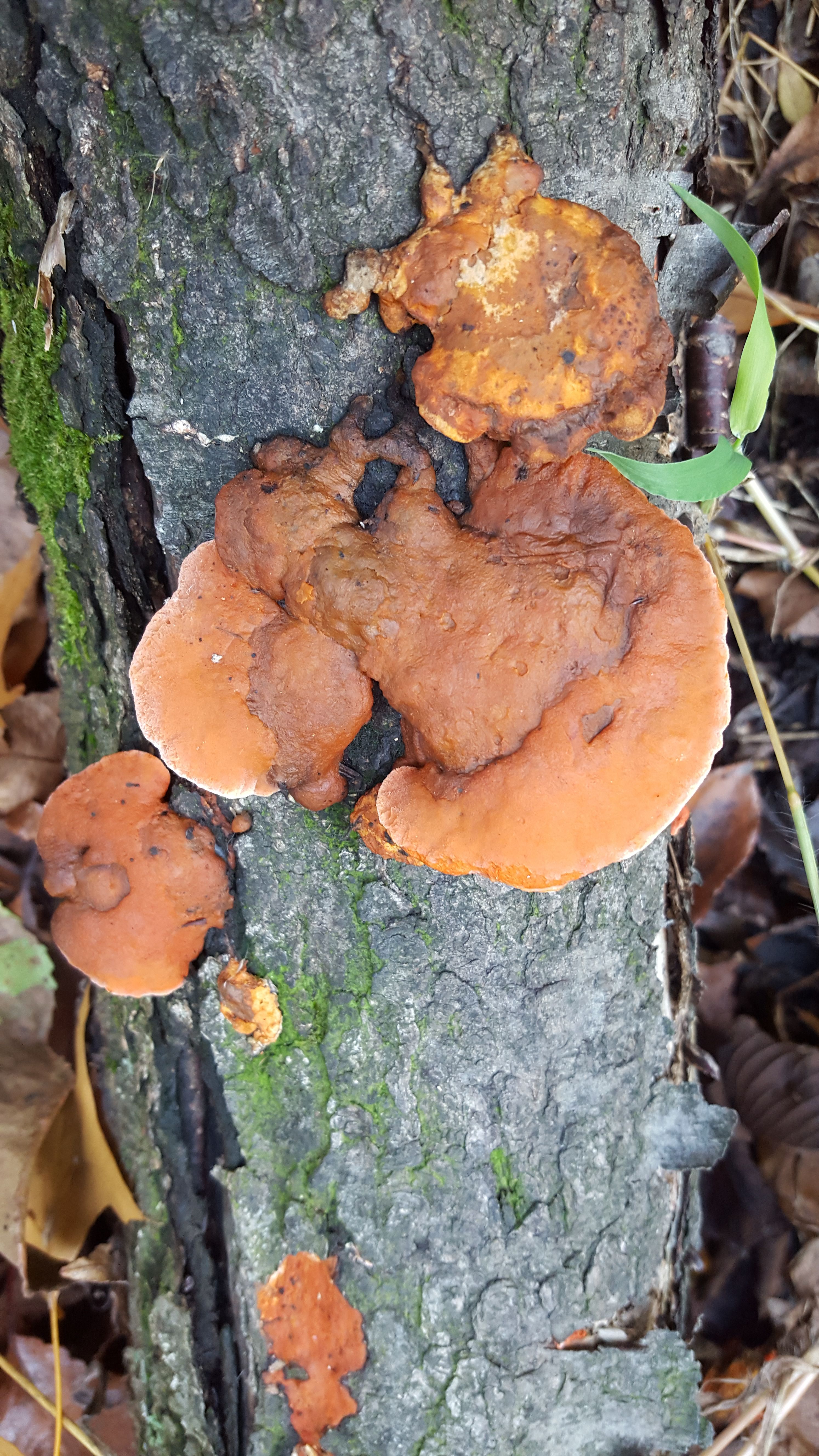
At first glance, you could be forgiven for mistaking these mushrooms for Ganodermas
However, the mushroom pictured above is not a Reishi mushroom - it isn't a Ganoderma at all. In fact, it is a completely different genus entirely.
Let's take a closer look at a slightly younger cap.
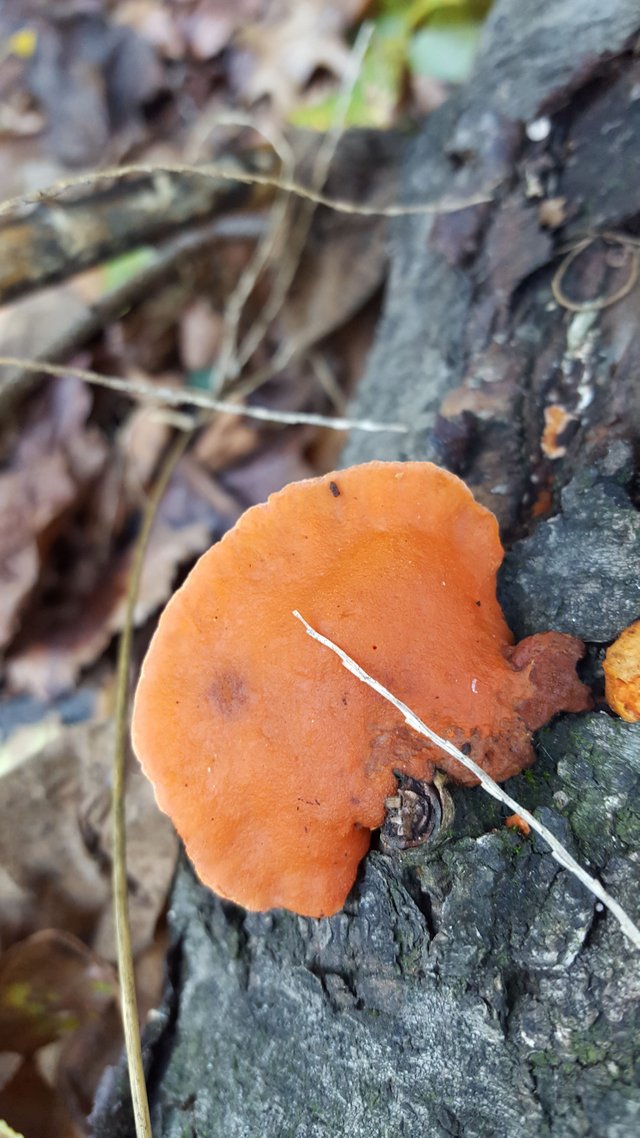
Already things are looking a lot less "Ganoderma-ish"
The red/orange color is too uniform and matte. There doesn't appear to be a tough outer skin. In fact, this thing looks downright fleshy.
Let's get in there and give it a touch.
This is definitely NOT a ganoderma!
This is Pycnoporus cinnabarinus, and although the slightly older specimens look vaguely like Ganoderma at a glance, the resemblance begins to wear very thin, very quickly. If you have any lingering doubts, a quick, squishy poke will dispel them entirely!
Alternatively, you can take a cap and flip it over to see the real show!
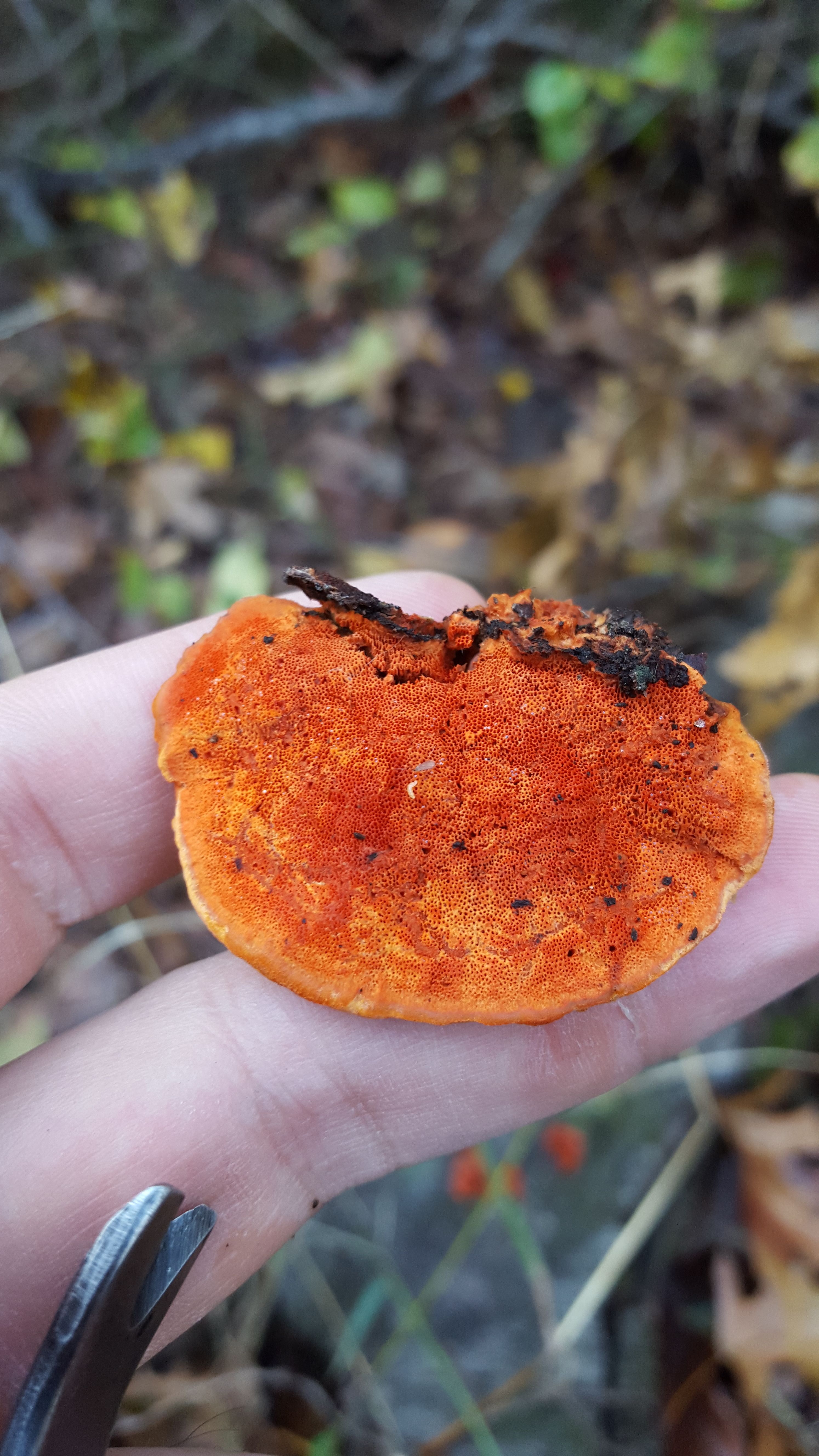
Look at that vibrant pore color!
These caps were all on the older side, but they still retained the most vibrant red/orange pores I've ever seen in person on a mushroom. The Pycnoporus genus is known for the vibrant red/orange coloration of its pores. In conjunction with its polypore structure, saprobic log growth, and fleshy texture, the awesome pore colors make for a fairly unique and identifiable mushroom.
But what really makes P.cinnabarinus awesome is its various practical and industrial uses. This is a topic I have not yet expounded upon much - but P.cinnabarinus is a perfect place to start.
But before we get into all that, let's get clear on the mushrooms other macroscopic traits.
The single log I found had the mushroom in old, middle aged, and incipient form. Take a look at the baby version.
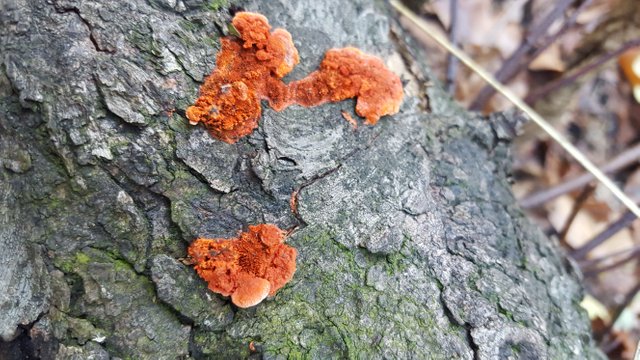
These incipient specimens almost look like a slime mold, but for the tiny caps
P.cinnabarinus is a fairly common mushroom, on average, in North America. However, it can be exceedingly rare based on locality, and apparently without muc rhyme or reason. Kuo says he has only seen this mushroom twice in over a decade. I just saw it on my fourth major walk through Central Park. Others seem to find pounds of the stuff.
Wherever it grows, it will always be saprobic, on a dead log. There is anecdotal talk of it preferring newly downed trees or specific species, but nothing is consistently reported to that effect.
The mushrooms doesn't like it too cold, but in temperate areas can be seen almost year round.
Let's look at a cross section
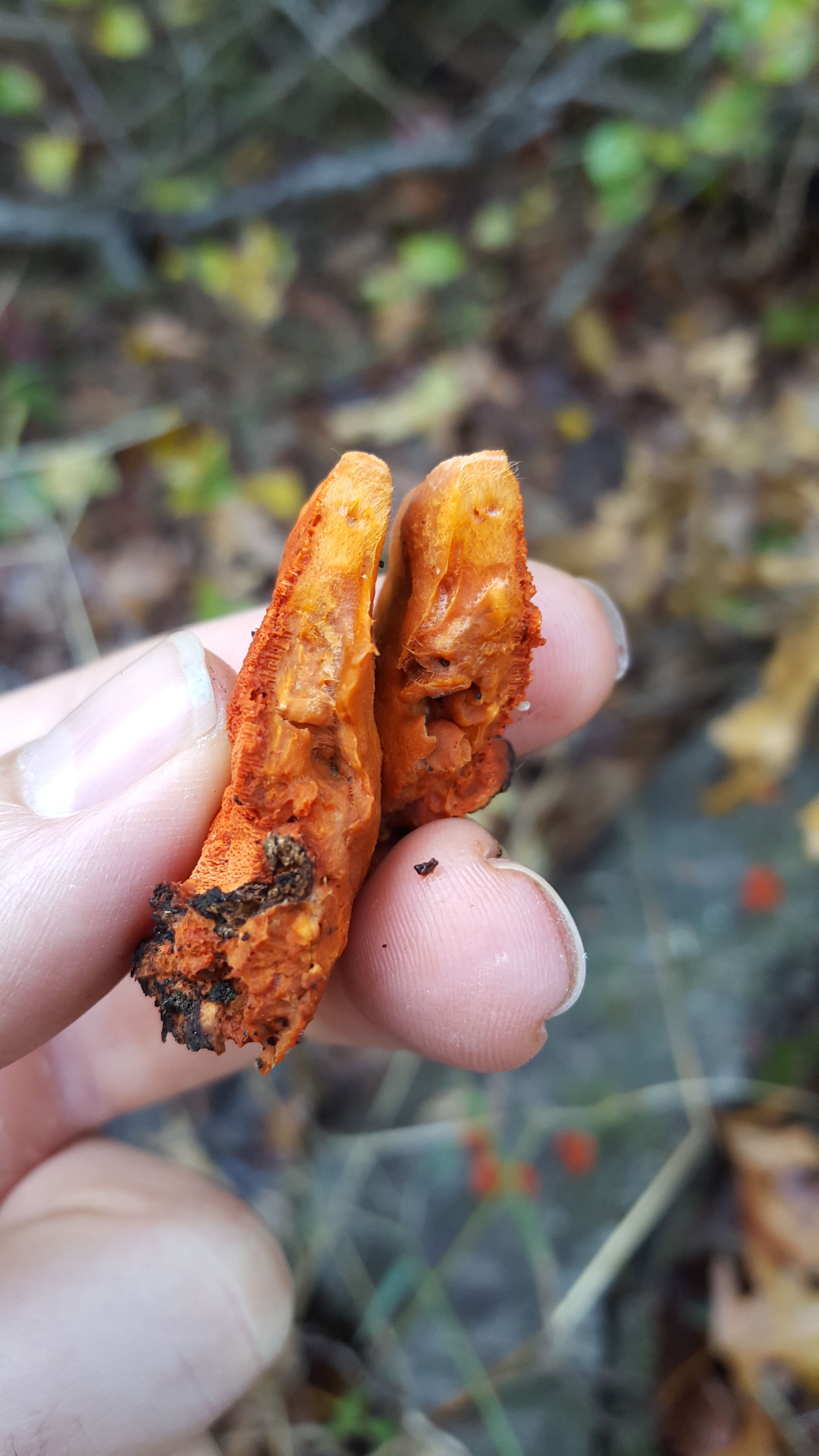
The flesh color mirrors the cap and is roughly uniform throughout.
The pore layer can be clearly distinguished and the flesh does not change color when bruised.
In case you have any lingering doubts about whether you have P.cinnabarinus or a Ganoderma, your fairly easy ability to tear the cao in half with your hands, and the lack of a dark brown interior flesh, will leave no doubt.
You can also see the clearly delineated pore surface stretching a couple of mm through the body of the mushroom.
This is also the first species we've highlighted to have a relevant KOH reaction. But as we'll see, this can sometimes be a source of confusion as much as edification.
Take a look at the KOH reactions on this specimen, several minutes after KOH was applied.
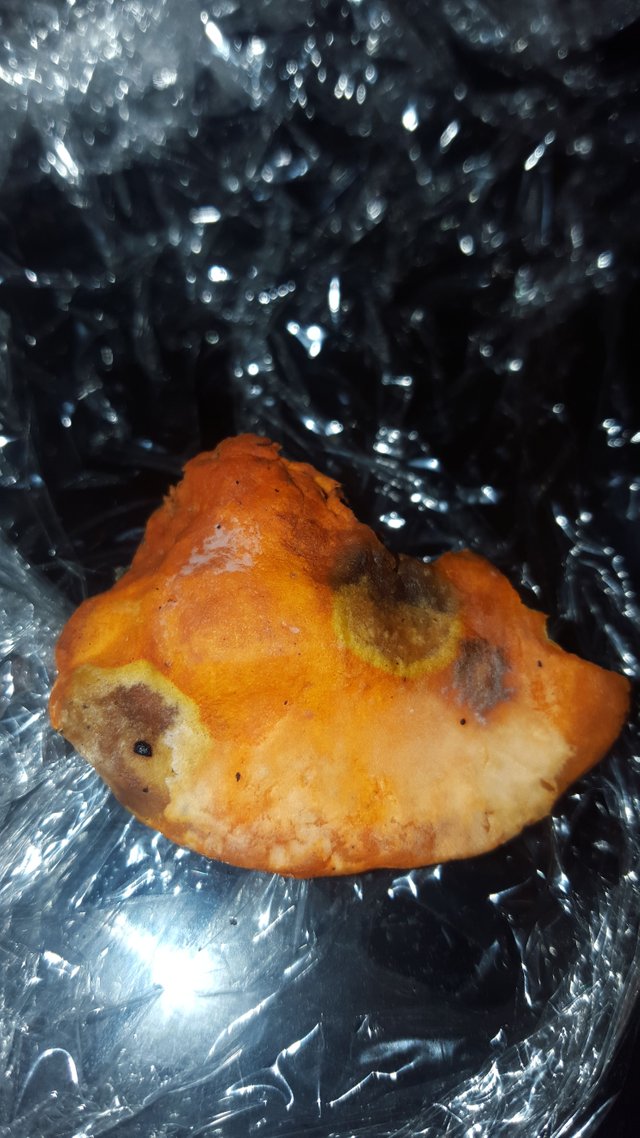
This is the top of the mushroom - brown centers with yellow edges.
The spots would yellow even more with time.
Now take a look at the pore surface KOH reactions in the same timetable.
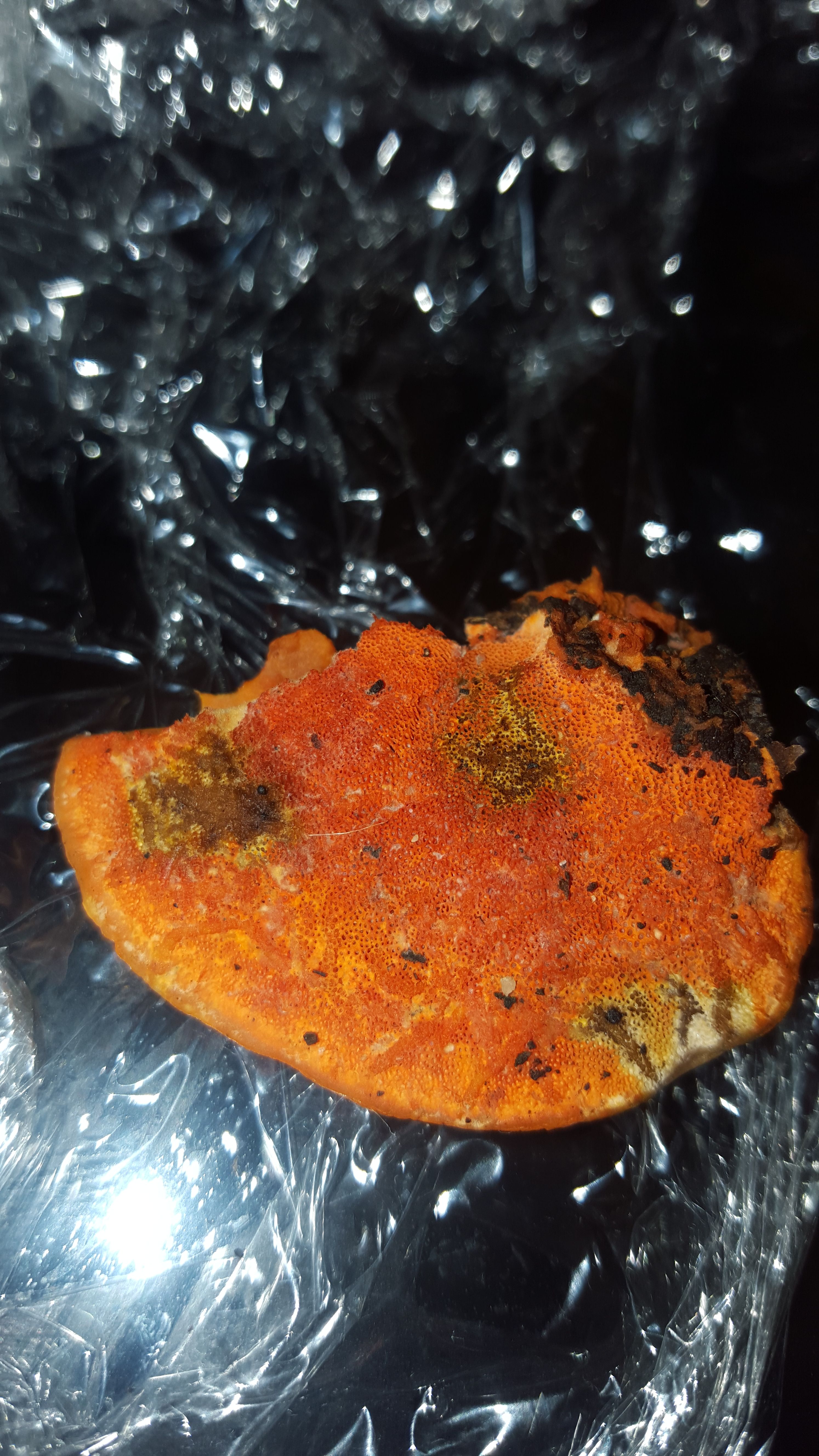
Similar coloration to the cap stains
A darker, brownish center with yellowing around the edges.
However, when I first dropped some KOH on a seperate piece of pore surface several hours earlier, the reaction was a much darker and more consistent brown, becoming almost black.
Take a look at that, and note the speed of the initial reaction.
A younger cap also presented a different coloration on top, ending up at a light matte brown.
Confusingly, that leaves us with three different KOH reactions:
On the cap of a fresher mushroom - light brown
On the pores of a fresher mushroom -Brown to blackish
On the cap and pores of a mushroom 24 hours after harvest - brown fading progressively to yellow around the edge.
Now compare this information to the KOH reactions provided by Kuo:
Cap surface purplish to reddish, then gray to black with KOH; pore surface olive green with KOH; flesh slowly reddish to blackish or in older specimens yellowish with KOH.
Huh?!
Not only is that grammatcally confusing, but the colors hardly seem to line up at all! At this point I started to wonder if I had the wrong mushroom entirely. But then I looked at the photos Kuo has up of the KOH reactions, and they look fairly similar to the older pore reaction and younger cap reaction.
I also did some seperate google scholar research on the species and found an Indian research paper that investigated its uses and characteristics in some detail. They indicated only a blackening reaction to KOH, which is consistent with the fresher pore surface reaction I saw.
What is one to make of this confusion? Well, the KOH has definitely assisted in placing the genus. However, the vagueries of color descriptions versus photos, and even the specifics of individual specimen reactions, can sometimes make for more confusion than clarity.
Last question is the spore print - should be white.
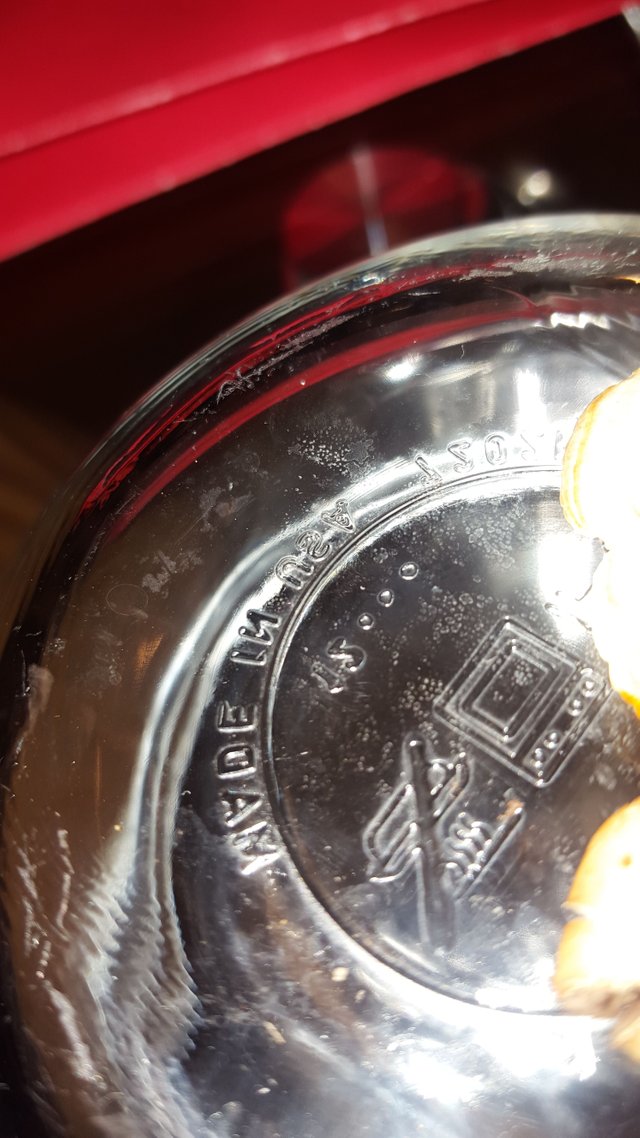
The cap was pretty old and pretty wet, but we got a scant white print out of it nonetheless which you can see in this photo.
Given the host of positive identifying traits, despite the mixed KOH results, I feel comfortable identifying the species in this case. Comfortable enough that I made it into a full out species post.
Practical applications:
Many mushrooms have practical or industrials applications beyond being food or their utilitarian purpose in the ecosystem. Obviously, P.cinnabarinus breaks down dead wood. But it also has at least a couple of awesome uses:
Making natural orange dye - A quick squeeze of the fresh cap releases a good amount of orange tinted fluid. However, if you collect multiple caps, and the mycelium itself, you can extract a fairly color fast orange dye that can be used on a variety of mediums.
Harvesting Laccase for industrial uses - Laccase is an enzyme present in several mushroom species. It can be extracted from P.cinnabarinus and then utilized in several potential applications - including bio-fuel battery designs, tooth whitening, dyeing, and a bunch of other stuff I don't understand - including a wide variety of purposes as a food additive
This is just the tip of the pragmatic iceberg of mycological uses. We will talk in the future about how much deeper the rabbit hole may go.
MACROSCOPIC CHARACTERISTICS
Cap = fairly uniform red/orange color, at first quite bright and slowly fading as the cap ages - the surface of the cap was suede like in its texture, but Kuo indicates possible small hairs as well. Shelf like or kidney shaped, as you see in the pictures above. 2-13cm in width range, 2cm or so in thickness. Doess not bruise.
Spore surface = bright orange/red, dulls with time but not as much as the cap.
Flesh = Tough and fleshy - juicy after rain - consistent dark orange, but tearable by hand. Does not bruise.
Stem ("stipe") = none
Spore Print = White
Ecology ("How it grows.") = Saprobic on dead logs. Kuo specifies mostly hardwood, but allows for conifers. Seems pretty equal opportunity overal. Can be spring through fall or year round in temperate areas.
Distribution = Common on average inNorth America, but can be rare in specific localities.
Other = Cap and mycelium can be harvested for orange dye and the enzyme laccase for industrial uses.
THIS POST IS NOT INTENDED FOR FORAGING PURPOSES AND TO USE IT FOR THOSE PURPOSES WOULD BE DANGEROUS. DO NOT HUNT WILD MUSHROOMS WITHOUT RELYING ON A COMBINATION OF PROFESSIONAL FIELD GUIDES, IN PERSON PROFESSIONAL GUIDANCE, OR IN PERSON GUIDANCE BY SOMEONE TRUSTWORTHY WHO HAS COPIOUS LOCAL, SPECIALIZED MUSHROOM HUNTING EXPERIENCE. FAILURE TO DO SO CAN RESULT IN GRIEVOUS PERSONAL HARM OR DEATH.
Photos Are My Own
Information Sources:
[1]Kuo on P.cinnabarinus
[2]Wikipedia On P.cinnabarinus
[3]Messiah College on P.cinnabarinus
[4]"CHARACTERIZATION AND CONSERVATION OF EDIBLE AND
MEDICINAL MUSHROOMS OF WESTERN GHATS OF INDIA", by Meera Pandey and Veena S.S, Society for Promotion of Tropical Biodiversity, Jabalpur, Indian J. Trop. Biodiv. 20(1) : 37 - 44(2012)
[5]Eggert, Claudia, Ulrike Temp, and Karl-Erik Eriksson. "The ligninolytic system of the white rot fungus Pycnoporus cinnabarinus: purification and characterization of the laccase." Applied and Environmental Microbiology 62.4 (1996): 1151-1158.
APA
[6]Wikipedia on Laccase
Wow, that is what i call a post, fantastic and i love mycology stuff so will follow you.
Thanks for that!
magic mushroom
Nice post, thanks for the follow too, followed you right back @rishherbalist
Great photo!
There are so many pretty polypores! I wonder what sort of poundage or tonnage is being harvested to support industrial uses of these bracket fungus! Nice to see you using your KOH. The color changes in mushrooms is so fascinating. I found some boletes yesterday that sure stain blue, so quickly. And so many Dyer's Polypores this fall, with their fast-staining brown reaction. Here's to fun with fungi! :D
It's a big step for me finally getting some reagents ready. Also, sneak peak, I should have another important advancement coming soon. It should be able to calibrate my microscope so that I can measure Spore size and other characteristics. For number of mushrooms specifically anything terrestrial very small and brown or white, this kind of microscopic work can be very important. I still won't be able to do the really detailed stuff at least not until I get a new microscope that's a little bit better. But this should add yet another element of detail to these posts, which I'm excited about.
That is pretty exciting! Macrocharacteristics can only get us so far, that's for sure! And then you can work on that DNA lab! DNA analysis has changed so much of what's known about fungi speciation these days! Especially with splitting up what were thought to be one species for so long. It's hard to keep up with it all. And then there's the reclassification changes, too. I'm looking forward to your microscope efforts and seeing how it changes how you are working with the various mushrooms! :D
As a self-proclaimed mushroom nerd you are speaking to my heart. I look forward to viewing your work. Thank you for creating excellent content.
Glad you found me - always looking for other mycology buffs
I really appreciate your deep knowledge of mushrooms including this particular variety but more importantly I appreciate that fact that you tell people that your descriptions are not scientific fact and are geared for entertainment purposes mostly.
your posts are always a nice surprise in my feed :D
I appreciate your saying that - it's turned into a fulfilling exercise for me too.
Upvoted and RESTEEMED!
That's amazing...i like your post. Thank you for your sharing
nice post dber, very informative and great photos. I've always be interested in mycology and recently was able to buy a copy of mycelium running (which I'm sure you know about) after wanting it for a few years. I was very excited to get it. Keep up the good work.
Thanks for the kind words - and welcome to the hobby. I haven't read his book, but Stamets is totally awesome. Let me know how it is!